In this day and age, we are all aware of our impact on the planet. As a gadgeteer with gadgets galore, I often feel guilty when it comes to charging their batteries using various AC adapters plugged into sockets all over my home. So, what could be better than a way to charge these gadgets without increasing your carbon footprints every day? How about a charger that uses the sun? The Solio H1000 Universal Hybrid Charger claims to help you with this task. Let’s check it out…
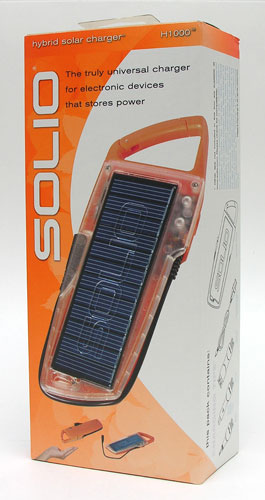
Hardware Specifications
Rechargeable battery 3.7V 1000mAh (Lithium Ion
Rated output: 1.5 to 5 watts
DC input charge range: 5-6 volts at 400mA
Solar panel output: 0.6 watts
Dimensions: 198 x 68 x 18mm
Weight: 4.6 oz.
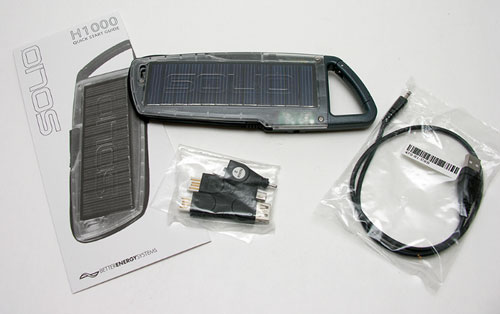
Package Contents
Solio H1000
USB Charging Cable
USB Port Replicator tip
Mini-USB tip
Nokia tip
Instruction manual
The H1000 is 5 x 1.5 inch solar panel incased in a plastic shell. The solar panel is connected to a Lithium Ion rechargeable battery. The idea is that you use the sun to charge the internal battery and then connect the Solio to other devices to charge them using that stored power.
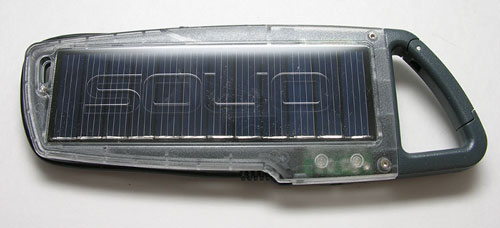
You can see the solar panel through the clear plastic on the front of the Solio. On the bottom Right corner, there are two status LEDs. One for charging and one for battery capacity information. A plastic carabiner is built into the Solio for easy attachment to a gear bag or other items.
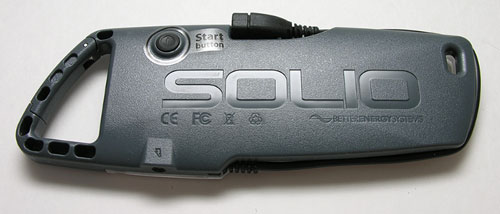
The back of the case is Grey and has a rubber button. When you press this button, the battery capacity LED on the front of the Solio will blink Green to indicate how much juice is left in the internal battery. Four flashes indicates a full charge, three flashes about a 75% charge, two flashes for 50% and one flash for a 25% charge.
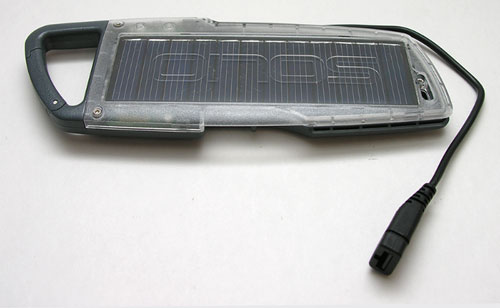
A ten inch cable is built into the Solio. This cable is used to connect to other devices to charge their batteries.

Included with the H1000 are three adapter tips. There is one for most newer Nokia devices, devices that use a Mini USB connector, and then a universal USB connector so that you can connect the USB cable for an iPod or another device that you own that uses a USB cable for charging. You can purchase additional tips through the Solio website for around $10 per tip.
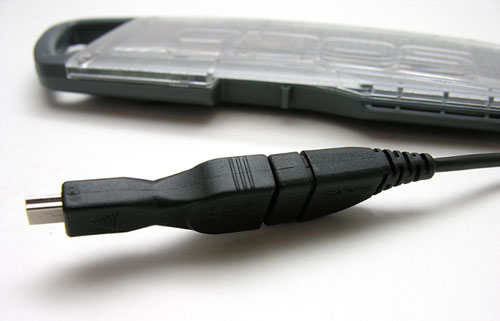
The tips are easy to install and remove.
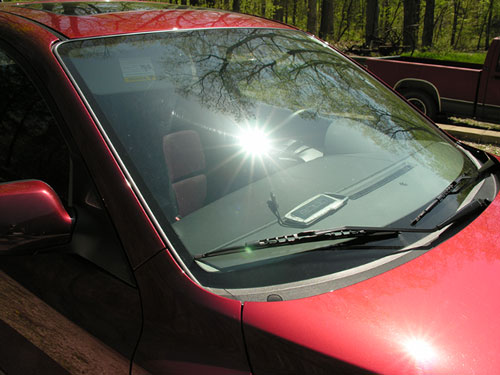
To charge the internal battery in the Solio, you have to place it in the sun. Big surprise right? Before I even received the Solio, I envisioned placing it on the dash of my car during the day and then using it to charge my devices at night. So every day while I was at work, it would be collecting power for me to use. Great plan… At least I thought so at first.
The first afternoon after receiving the H1000, I ran right outside and placed it on my dash. It was a perfect cloudless, sunny day and the charging status LED immediately started glowing Red, indicating that it was charging. Yay!!! This was going to be great. I ran inside to get my camera to take a picture for the review. By the time I got back with the camera, the charging light had turned off. Hmmmmmm….
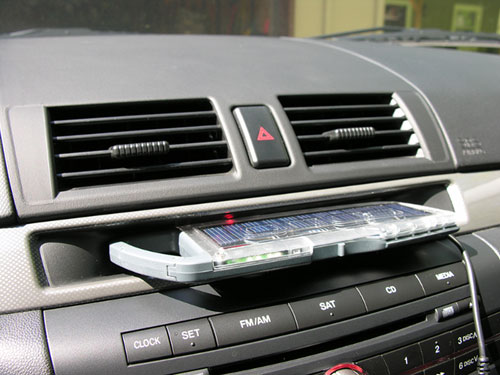
So I found another place to put it in my car and yay the charging light came back on again. Before I had started the charging process, I’d checked the battery status and it was at 50%. Five minutes later the sun had drifted a bit, causing the charging LED to go off again. So I placed the Solio on the sidewalk in full sunlight. Back on went the Red charging LED. A few hours later, I had a full charge.
I brought the Solio indoors, connected the universal USB adapter and then connected a Treo charging cable. I had a completely dead Treo 680, so I expected the Solio’s 1000 mAh battery to at least charge the Treo’s 1200 mAh battery to around 75-80%. A couple hours later when I checked, charging had stopped and the Solio’s battery capacity was down to 25% (1 flash). Checking the Treo’s battery showed that it had only charged to 26%. Hmmm… By this time, it was night time, so I didn’t have time to recharge the Solio by the sun, but included with the Solio is a USB charging cable. With it, you can charge the Solio’s internal battery with your computer. So I fully charged it and then once again connected it back up to my Treo 680. A couple hours later, the Treo was up to 53% and the Solio was back down to 25% capacity.
The next day I took the Solio with me to work and left it on the dash of my car all day long. It was a bright sunny day, so I thought it would probably charge up to at least 50-75%. Unfortunately it did not charge at all. I later came to learn that the Solio is extremely picky about any shadows falling over the solar panel. Even the tiniest shadow will cause charging to stop. I also found that tint in windshields will pose a problem with charging. As will a dirty window. I quickly came to the realization that my fantastic idea to charge the Solio during the day and then have it charge my devices during the night was not going to turn out as planned.
The Solio will work as advertised, but to charge it with the sun, you need to be very proactive. You need to put it in a place where there are no shadows and where the sun hits it directly. For most people this will probably make this device more trouble than it is worth. At least for me, I found that the be true. According to the people at Solio, their classic version of the charger is much easier to charge as it has 3 solar panels instead of just the 1 in the H1000. It’s more forgiving of shadows and other issues that I experienced.
As far as recharging your devices with the Solio, it will work depending on the battery capacity of the device you connect to it. Most of my devices have batteries that are larger than the Solio’s 1000 mAh battery. So, the best way to use the Solio is as a top-off device. Don’t allow your devices to go completely dead and then expect the Solio to recharge them to 100%.
Although the Solio didn’t quite live up to my expectations, I still think it’s a product that I hope we see more and more of. I want a more robust version of the Solio that I can put on my car dash and not worry about the tint in the window or if a cloud floats past the sun. Until there is a convenient way to be green, I’m afraid I’ll to continue to be … another color. :o)
Solio Universal Hybrid Solar Charger (Silver)
$89.97 (as of October 13, 2025 18:48 GMT -04:00 - More infoProduct prices and availability are accurate as of the date/time indicated and are subject to change. Any price and availability information displayed on [relevant Amazon Site(s), as applicable] at the time of purchase will apply to the purchase of this product.)Solio Classic Universal Hybrid Charger (Silver)
$99.99 (as of October 13, 2025 18:48 GMT -04:00 - More infoProduct prices and availability are accurate as of the date/time indicated and are subject to change. Any price and availability information displayed on [relevant Amazon Site(s), as applicable] at the time of purchase will apply to the purchase of this product.)Product Information
| Price: | 79.95 |
| Manufacturer: | Solio |
| Pros: |
|
| Cons: |
|



Gadgeteer Comment Policy - Please read before commenting
I’m still waiting for a flat piece of solar panel that i can stick to my dashboard to charge my phone, one that’s about the size of a apple keyboard. I haven’t found any Solar Chargers that meet my expectations… 🙁
Roy:
I’m in the same boat as you… I would like to try Solio’s classic version that looks like a flower. It has 3 solar ‘petals’.
Good story, good try – but this dog don’t hunt. They still have a way to go. But – solar power is the big “thing” now. I sure would like to find an inexpensive and EASY way to save on power costs.
I’ll look for the Solio’s classic version, but the problem is that it can’t store so much energy that it can fully charge my phone. I’ve done some searching and found a company called MINIWIZ, they created a Wind powered handheld universal charger called HYmini, and the miniSOLAR. (i won’t get into the details, because it would go on forever) but their website is: http://hymini.com You should check it out. The price is actually cheaper then the Solio H1000. $74.98 can get you the HYmini and the miniSOLAR panel, (usually sold separately) extra solar panels are $24.99. The store is at this link: http://hymini.com/eshop/index.html (also linked in the info page)
EDIT: Julie, it would be great if you can review this product. I would like to purchase it if it actually works.
[Edited at May 15, 2008 17:12:26 PM.]
The solar cells must all be connected in series – shaded cells act like dead batteries, so would stop the whole works. They should have included some parallel paths.
I wonder if this Sunsei works better:
http://www.solarcharger.com/s.nl/it.A/id.64/.f?sc=2&category=62
The are sold at Fry’s for about $30. There are some good reviews of this product on Amazon.
I checked out both websites mentioned in the 2 previous comments. The Sunsei looks like a scaled-down version of the hybrid Julie tested – wonder if it has the same limitations?
The HYmini looks like something I would definitely like to test to see if it really can power anything for very long. It’s got solar power and wind power adapters, you can charge it on your pc/laptop, or in the wall plug. Heck! You can even hand crank the dang thing.
Now, all I need to know is if it is any better at powering up devices than the Solio.
Roy:
Unless I’m blind and missed it, there isn’t any info about the power storage capacity of the HYmini and miniSOLAR products. Hmmmmm….
BL:
The Sunsei product does look very similar to the Solio. It says it has 135 mA. How does that compare to mAh? Hmmmmm….
Julie, the HYmini has a battery inside, while the miniSOLAR does not. if i remember, in the FAQ section, it mentions how much mAh the batter inside the HYmini is.
EDIT: Copied directly from the HTML version of the site:
1200 mAh built in lithium ion polymer rechargeable battery power bank.
5V adaptive 200~850mA output through USB 2.0. —–(output to device is USB)
Built-in rechargeable battery inside the casing.
[Edited at May 15, 2008 22:06:31 PM.]
Hi Julie,
I have owned a solio classic for over a year now. It is a fantastic bit of kit and I can tell you it is not picky about sunlight conditions like you describe with the H1000. It can charge even with very little sunlight. I charge my trusty Palm Centro with it every couple of days.
Keep up the great reviews !
Regards….Will
Roy:
I have a feeling trying to charge via the wind would have more issues than sunlight… Unless if you were an avid cyclist or something, of which I am not.
William:
Thanks for the info on the classic. One question for you… You say that you use the classic to charge your Centro. Do you use it as a top-off charger, or have you been able to use the classic for a complete recharge?
Julie: i think the HYmini has a mount for your car, while you are driving it would charge the built-in battery. But if charging through wind is a problem, the solar panel would cover the wind problem. and the price covers both the Wind generator and Solar….
[Edited at May 16, 2008 23:17:54 PM.]
Hi Julie,
I use the solio classic to keep my centro topped up every couple of days. I have found that there is not enough juice for the classic to fully charge an empty centro battery.
How’s life now that you have moved back to a centro? I have to say that Palm have really hit a winner with the centro. It really is a great phone/PDA combo.
Regards,
William.
William:
Where do you charge your Solio Classic? I’m curious if it is easier than the H1000. I would hope so…
I’m loving the Centro! :o)
Hi Julie,
I live in the UK, so I just have my solio classic stuck to a south facing window where it can maximise the amount of sunlight….works a treat….when it’s sunny !
cheers…Will
The H1000 from Solio is good but the newest is their best, the Solio Mag. Gives you over 5 hours of power for your iPhone full charged.
The H1000 is typical of many small solar chargers. In order to keep the device small & manageable, they lose charging ability. To make them more powerful per square-inch, they use higher-grade single-crystal solar cells, which raise the cost, and also make the charger not as tolerant of partial shade & low-light conditions (as noted in this review).
One thing that was not noted, is that you CAN plug your device into the Solio and get a charge while the Solio is charging from the sun… basically giving your iPhone, Blackberry, or Treo a solar panel direct to its battery. You DO NOT have to wait until the Solio itself is fully charged before using it to charge your devices.
But, I agree that the H1000 is somewhat underpowered, and am looking forward to the new ruggedized models from Brunton…
http://www.modernoutpost.com/gear/details/br_restore_81-000006.php
The best option at the moment for FAST USB charging, is to use the PowerFilm products, which have the best low-light performance, offer 1.4 Watts of solar, fit onto a dashboard, and also use high charge retention NiMh AA’s for power storage & USB power boost…
http://www.modernoutpost.com/gear/details/pf_powerfilm-usb-aa.php
That is about all I have to say.
Thanks for the review!